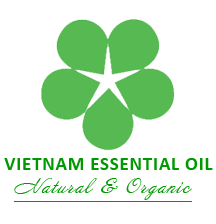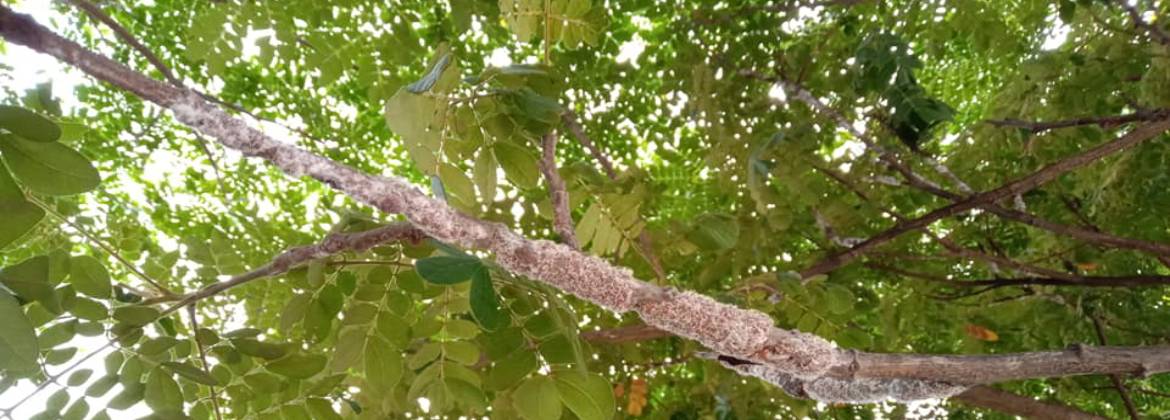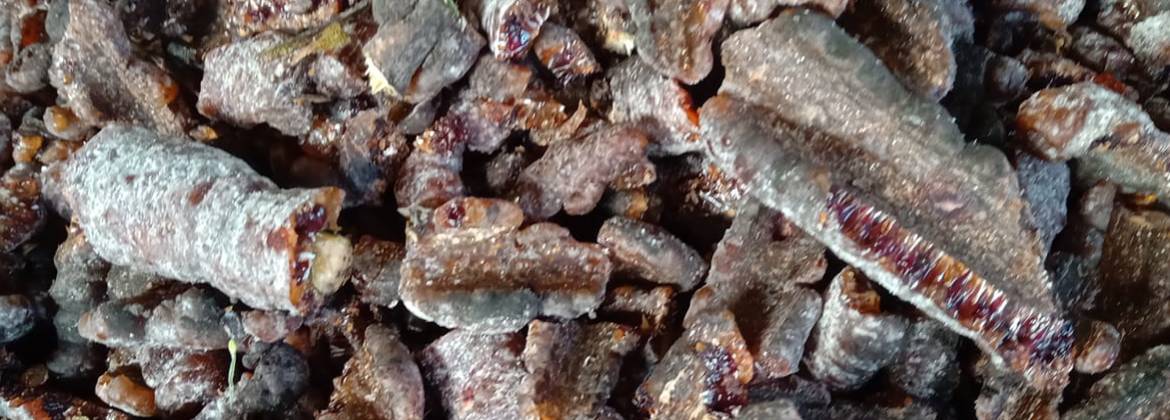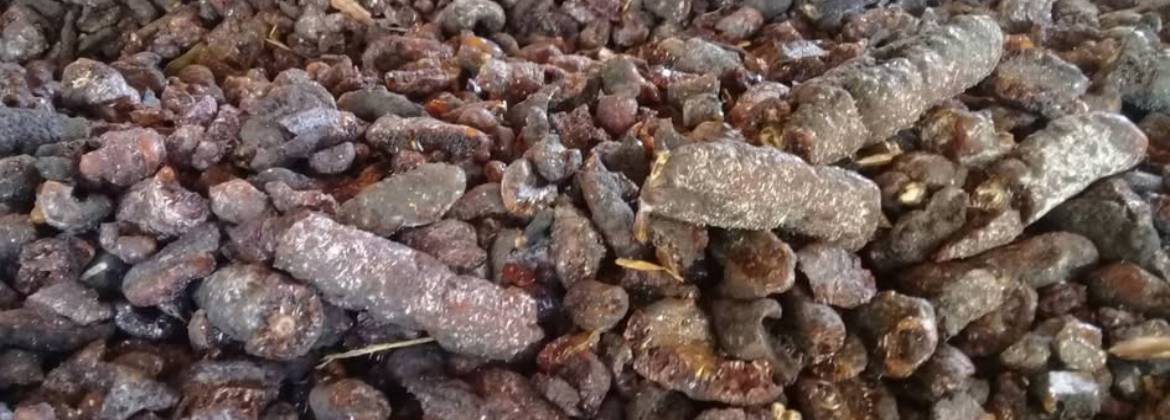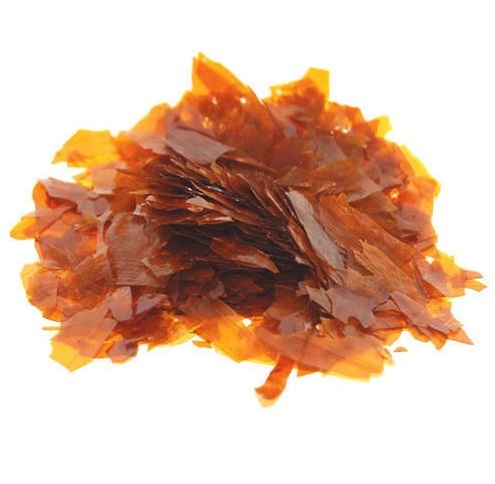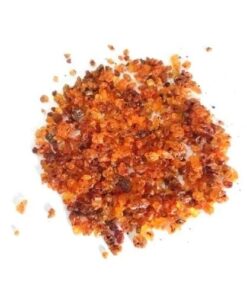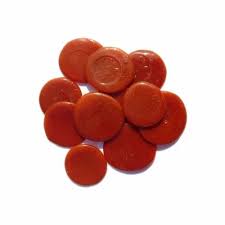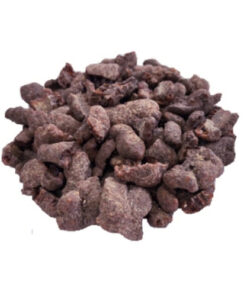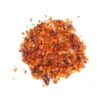Sticklac is the resinous secretion of a kind of tiny insect known as Laccifer lacca.
During harvesting, the lac encrusted twigs are cut from the host plants. Then the lacs are removed from the twigs by scrapping. The lac thus obtained is known as stick lac or scrapped lac or crude lac or raw lac, that contains insect body, lac dye, sand and twig debris, in addition to resins.
The lac most commonly used across the world is shellac which is produced by any of the following processes:
(a) Indigenous Process/Country Process:
In this traditional method, the seed lac is first filled into long sausage-shaped cloth bag of about 2 inches diameter and 30 feet length. The bag is then gradu¬ally passed in front of a charcoal-fired hearth to melt the lac. By twisting the bag, the molted lac is then squeezed out through the sieve of the cloth.
This molten filtered mass is then either stretched into sheets of about 0.5 cm thick with the help of glazed ceramic cylinder, or allowed to solidify in form of dice, called button lac. The residue left inside the cloth bag contains apart from lac, sand, insect debris, and is referred to as kirrilac.
The shellac obtained by such method are available in various commercial forms like Lemon one shellac, Lemon two shellac, Superior shellac, Kusmi button lac, Light pure button lac, etc.
(b) Heat Process :
In this process, the seed lac is melted by steam heat. Oxalic acid and titanium dioxide are mixed with the melted lac at this stage. The molten lac is then squeezed through filter by means of hydraulic pressures. The filtered molten lac is drawn into long and continuous sheets with the help of roller .
These sheets are broken into pieces, called flakes. Various grades of machine made shellac flakes are available commercially, that include Orange shellac, Black T.N. shellac, Orange fine shellac, etc.
(c) Solvent Process:
In this process, the seed lac is dissolved in refrigerated alcohol and then filtered through filter press to remove the wax and other impurities. The lac thus obtained is dewaxed lac. The alcohol is then removed with the help of roller; the molten shellac is then stretched.
The solvent process may yield various grades of commercial shellac, like Dewaxed platina, Dewaxed blonde, Dewaxed lemon, Dewaxed garnet, etc.
By the same process, decolourised lac can be obtained by removing the colour (to any required standard) through charging of the dissolved lac with activated carbon.
The basic procedure of bleached shellac manufacture includes following steps:
(1) Dissolving the shellac in aqueous sodium carbo¬nate solution at 90-100°C;
(2) Stirring with sodium hypochlorite and
(3) Filtering after cooling.
The bleached shellac, thus obtained, is then reclaimed from the filtered solution with sulphuric acid. This bleached shellac is then again filtered and finally dried. The bleached lac is white in colour and com¬mercially available in two grades, dewaxed bleached shellac and waxy bleached shellac.
Specification


SPECIFICATIONS
Product name
|
STICKLAC
|
Cas No.
|
9000-59-3
|
Manufacturing date
|
12/2024
|
Expiry date
|
12/2027
|
Origin
|
Vietnam
|
Batch No.
|
SLAC1224
|
No
|
Specifications
|
Standards
|
01
|
Appearance
|
Dried resin
|
02
|
Colour
|
Orange-amber to brown resinous mass
|
03
|
Odour
|
Characteristic odour
|
04
|
Solubility
|
Soluble in alcohol & Insoluble in water
|
05
|
Chemical composition
|
Resin (65%)
|
Storage: Store in airtight containers in cool & dry place away from light & heat.
Caution: Avoid contact with eyes, inner ears, and sensitive areas.
MSDS

MATERIAL SAFETY DATA SHEET
(according to Regulation (EU) No. 1907/2006)
Product name: Sticklac Resin
Number: SLAC1223
1. IDENTIFICATION OF SUBSTANCE/PREPARATION & COMPANY.
Product name: Sticklac Resin
Manufacturer/Supplier: Vietnam Essential Oil., JSC
Add: Bai Dai Village, Tien Xuan Commune, Ha Noi City, Vietnam
Emergency telephone: +84 903561868
Emergency Contact: Mr. Peter Tron
2. COMPOSITION / INFORMATION ON INGREDIENTS.
Definition/Botanical Origin: Sticklac is the resinous secretion of a kind of tiny insect known as Laccifer lacca original Vietnam.
Composition: 100% pure & natural, raw material
CAS No: 9000-59-3
3. HAZARDS IDENTIFICATION:
This product is not hazardous. Not dangerous for the environment.
H304 May be fatal if swallowed and enters airways
H315 Causes skin irritation
H317 May cause an allergic skin reaction
H319 Causes serious eye irritation
4. FIRST-AID MEASURES:
Inhalation: Remove from exposure site to fresh air. Keep at rest. Obtain medical attention.
Eye contact: Rinse immediately with plenty of water for at least 15 mins. Contact a doctor if symptoms persist.
Skin contact: Remove contaminated clothes. Wash thoroughly with soap & water, flush with plenty of water. If irritation persists, seek medical advice.
Ingestion: Rinse mouth out with water. Seek medical advice immediately.
Other: When assessing action take Risk & Safety Phrases into account (Section 15)
5. FIRE FIGHTING MEASURES.
Extinguishing media Use CO2, Dry Powder or Foam type Extinguishers, spraying extinguishing media to base of flames. Do not use direct water jet on burning material.
Special measures: Avoid vapour inhalation. Keep away from sources of ignition. Do not smoke. Wear positive pressure self-contained breathing apparatus & protective clothing.
Extinguishing procedures: Closed containers may build up pressure when exposed to heat and should be cooled with water spray.
6. ACCIDENTAL RELEASE MEASURES.
Personal precautions: Avoid inhalation & direct contact with skin & eyes. Use individual protective equipment (safety glasses, waterproof-boots, suitable protective clothing) in case of major spillages.
Environment precautions: Keep away from drains, soils, surface & groundwaters.
Cleaning up methods Remove all potential ignition sources. Contain spilled material. Cover for spillages: with an inert or non-combustible inorganic absorbent material, sweep up and remove to an approved disposal container. Observe state, federal & local disposal regulations.
7. HANDLING & STORAGE.
Precautions in handling: Apply good manufacturing practice & industrial hygiene practices, ensuring proper ventilation. Observe good personal hygiene, and do not eat, drink or smoke whilst handling.
Storage conditions: Store in tightly closed original container, in a cool, dry & ventilated area away from heat sources & protected from light. Keep air contact to a minimum.
Fire protection: Keep away from ignition sources & naked flames. Take precautions to avoid static discharges in working area.
8. EXPOSURE CONTROLS/PERSONAL PROTECTION.
Respiratory protection: Avoid breathing product vapour. Apply local ventilation where possible.
Ventilation: Ensure good ventilation of working area.
Hand protection: Avoid all skin contact. Use chemically resistant gloves if required.
Eye protection: Use safety glasses.
Work/Hygiene practices: Wash hands with soap & water after handling.
9. PHYSICAL & CHEMICAL PROPERTIES.
Appearance: Dried resin
Colour: Orange-amber to brown resinous mass
Odour: Typical
Specific gravity at 20℃: not available
Refractive Index at 20℃: not available
Optical rotation at at 20℃: not available
Main components: Resin
Solubility: Insoluble in water./ Solubility in alcohol, solvents
10. STABILITY & REACTIVITY.
Reactivity: It presents no significant reactivity hazards, by itself or in contact with water. Avoid contact with strong acids, alkali or oxidising agents.
Decomposition: Liable to cause smoke & acrid fumes during combustion: carbon monoxide, carbon dioxide & other non-identified organic compounds may be formed.
11. TOXICOLOGICAL INFORMATION.
According to current information, not classed as hazardous to health in normal industrial use.
12. ECOLOGICAL INFORMATION.
Biodegradability: Data not available
Precautions: Prevent surface contamination of soil, ground & surface water.
13. DISPOSAL CONSIDERATIONS.
Avoid disposing to drainage systems and into the environment. Seek expert advice.
14. TRANSPORT REGULATIONS.
Shipping by road (ADR/RID): This product is not considered as dangerous goods
Shipping by air (IATA): This product is not considered as dangerous goods
Shipping by sea (IMDG): This product is not considered as dangerous goods
UN number: not regulated
UN proper shipping name: not regulated
Transportation hazard class: not regulated
Label: Sticklac Resin
15. REGULATORY INFORMATION. According to Directive 88/379/EEC
Hazards: Harmful
Symbols: n/a
Risk Phrases: Harmful if swallowed
Safety Phrases: If swallowed seek medical advice immediately and show the container / label
16. OTHER INFORMATION.
Cosmetics Directive – 7th Amendment – Not Restricted
Check maximum usage levels for skin care products.
PACKAGING:
In Jute bag 30-50kg
SHELF LIFE:
Best before of 24 months from the date of manufacturing.
Q.C. REQUIREMENTS.
In-line with general product specification. Always satisfy suitability for specific application.
The data provided in this material safety data sheet is meant to represent typical data/analysis for this product and is correct to the best of our knowledge. The data was obtained from current and reliable sources, but is supplied without warranty, expressed or implied, regarding its’ correctness or accuracy. It is the user’s responsibility to determine safe conditions for the use of this product, and to assume liability for loss, injury, damage or expense arising from improper use of this product. The information provided does not constitute a contract to supply to any specification, or for any given application, and buyers should seek to verify their requirements and product use.
Certificate of Analysis


CERTIFICATE OF ANALYSIS
No: 12/ 2024/SLAC
Product name
|
STICKLAC
|
Cas No.
|
9000-59-3
|
Manufacturing date
|
12/2024
|
Expiry date
|
12/2027
|
Origin
|
Vietnam
|
Batch No.
|
SLAC1224
|
No
|
Specifications
|
Standards
|
Results
|
01
|
Appearance
|
Dried resin
|
Complies
|
02
|
Colour
|
Orange-amber to brown resinous mass
|
Complies
|
03
|
Odour
|
Characteristic odour
|
Complies
|
04
|
Solubility
|
Soluble in alcohol & Insoluble in water
|
Complies
|
05
|
Chemical composition
|
Resin (65%)
|
Complies
|
06
|
Conclusion
|
Comply all of the standards for Sticklac.
|
Storage: Store in airtight containers in cool & dry place away from light & heat.
Caution: Avoid contact with eyes, inner ears, and sensitive areas.
